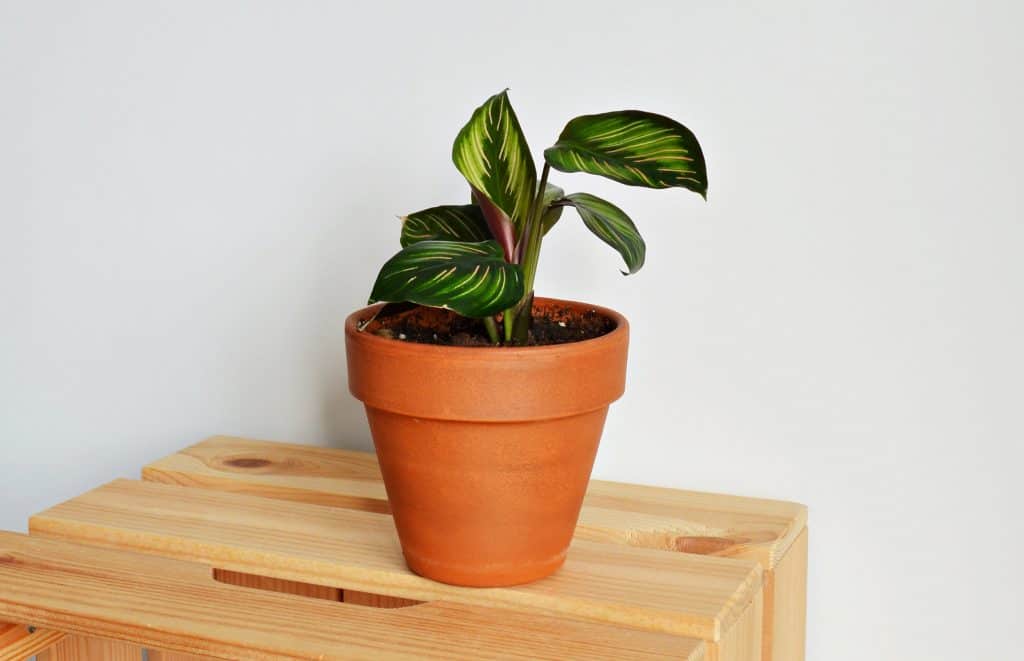| Common Name(s) | Calathea Beauty Star, Prayer plant, peacock plant, zebra plant, velvet |
| Scientific Name | Calathea Ornata ‘Beauty Star’ |
| Sun Exposure | Filtered or indirect |
| Soil pH | 6.5 |
| Watering Requirement | Moist but not waterlogged |
| Hardiness Zone | 11-12 USDA |
| Plant Height | 2 Feet |
| Plant Width | 2 Feet |
With an impressive array of silver, blush, and light green to yellow stripes on a background of rich deep green Calathea Beauty Star definitely lives up to its name. The underside of Calathea Beauty Star’s foliage is a pretty purple color. Its leaves splay out on individual stems showcasing the plant’s glorious stripes like a peacock shows off its tail feathers.
Calathea Beauty Star is low growing and spreads out because it’s used to receiving filtered sunlight through the tree canopy in the Brazilian rainforest.
As a member of the Marantaceae family, Calathea Beauty Star is a prayer plant and folds its leaves at night and opens them back up again in the morning.
The scientific name for Calathea Beauty Star is Calathea Ornata. Some of its other common names are prayer plant, peacock plant, and zebra plant.
What are the Benefits of keeping Calathea Beauty Star?
Studies are showing that keeping plants in your home can help boost your mood and make you generally happier. Who wouldn’t be happy gazing at a Calathea Beauty Star?
Calathea Beauty star does more than just look pretty though. It is an air purifier. Not only does it promote an oxygen increase in your space, it also filters pollutants out of the air you breathe.

Calathea Beauty Star Care
There are some specific needs for caring for Calathea Beauty Star. Humidity, watering, lighting, and temperature all need to be considered when it comes to having a Calathea Beauty Star in your home. They are not very forgiving when it comes to overwatering or underwatering.
How to care for Calathea Beauty Star as an indoor plant
When caring for your Calathea Beauty Star indoors, be sure the container your plant in has at least one drainage hole. Keep the humidity high by spraying the leaves regularly. Place your Calathea Beauty Star away from heating and cooling vents as well as drafty doors and windows.
How to Care for Calathea Beauty Star as an outdoor plant
Be sure your Calathea Beauty Star is in a shady spot where it can soak up filtered sunlight. It’s best to have your Calathea Beauty Star outside if you live in a warm humid climate. It is not keen on hot dry or cold wet environments. Vigilantly monitor your Calathea Beauty Star’s moisture levels.
Lighting Requirement
The very best place to put your Calathea Beauty Star is near a large north-facing window. This will give it the bright indirect sunlight it craves. If Your Calathea Beauty Star gets too much light it will scorch the leaves and cause discoloration. Too little sunlight and the beautiful variegation that is so appealing will fade.
If you don’t have a north-facing window an east-facing window is the next best choice, or you can try using a sheer curtain to filter the light in a south or west-facing window.
Soil Type and pH
One simple way to provide the right soil for your Calathea Beauty Star is to use a commercial mix prepared for African violets. If you do choose to mix your own soil, try a recipe of one part potting soil with two parts peat moss and one part perlite. Your Calathea Beauty star should have soil that is capable of staying moist but won’t be soggy.
Also, make sure the soil you choose is light. Heavy soil can damage the roots of your plant.
The Best pH for Calathea Beauty Star is 6.5
Water Requirement
Water your Calathea Beauty Star when the top inch of the soil is dry. Calathea Beauty Star likes to stay moist so give it a good drink and then let the excess water run out of the drain holes. Make sure you don’t leave extra water in a tray underneath your pot. If your Calathea Beauty Star sits in water it risks developing root rot. Don’t let the soil become waterlogged.
Don’t water your Calathea Beauty Star with water straight from the tap. They are sensitive to minerals that may be present in your tap water. You can use either rainwater or distilled water for your plant or you can leave tap water out on the counter for 12-24 hours until the minerals dissipate from the water.

Humidity Requirement
Calathea Beauty Star is native to the Brazilian rainforest so it loves humidity. The optimum humidity level for Calathea Beauty Star is 60% and above. If this seems like a lot of humidity for an indoor environment you’re not wrong. There are a few ways to give your Calathea Beauty Star the humidity it craves without making your home muggy and uncomfortable.
Mist your Calathea Beauty Star’s leaves with water every 1-2 days, move it to the bathroom where it can take advantage of the shower steam, and use a small humidifier near your Calathea Beauty Star (and any other humidity loving plants you may own) or place a tray of water and pebbles under your Calathea Beauty Star.
Temperature Requirement
A warm environment is ideal for Calathea Beauty Star. Keep it in an area where the ambient temperature is 65 degrees Fahrenheit to 85 degrees Fahrenheit. Do not let the temperature dip below 60 degrees Fahrenheit and try to avoid dramatic temperature fluctuations.
Hardiness Zone
The optimum hardiness zone for Calathea Beauty Star is 11-12 USDA
Fertilization
Using a liquid house plant fertilizer diluted to half of the recommended amount, fertilize your Calathea Beauty Star once a month during spring and summer when they are apt to do a fair amount of growing. Fertilizer can be held off in the Fall and Winter. Be careful not to overfertilize your Calathea Beauty Star.
Propagation
Propagation of your Calathea Beauty Star is best done during repotting in early spring. You’ll need rubbing alcohol, sheers or a sharp blade, soil, and containers with drain holes.
Start by uprooting the parent plant and gently removing the soil from the roots. Determine which stems correlate with which roots. Depending on the size of your plant you may be able to separate it into 3 plants with 3-5 stems each.
Sterilize your cutting instrument and slice through the roots cutting sections apart. Plant each Calathea Beauty Star in its own container with fresh clean soil.
You can not propagate Calathea Beauty Star by placing a cutting in water.
Calathea Beauty Star Size & Growth Rate
Calathea Beauty Star grows up to 2 feet tall and 2 feet wide. Indoors Calathea Beauty Star grows moderately fast and will reach its mature growth in about a year.
Common Problems
Spider mites and mealybugs are the most common pests to bother Calathea Beauty Star.
You can identify a spider mite invasion by the following signs: small red arachnids in your pot, tight webs on the underside of your plant, spotty leaves, or leaves turning yellow.
Spider mites tend to move in when the soil gets dry so keeping the soil moist is a good way to prevent infestation.
To cure spider mites, try giving your Calathea Beauty Star a shower to rinse them away, then use rubbing alcohol to wipe away pests. Follow up with neem oil. Repeat every 7 to 10 days as needed.
The same regiment can be followed for mealy bugs, or you can call in their arch enemies for help and release ladybugs onto your Calathea Beauty Star.
Leaves Curling
If your Calathea Beauty Star has curling leaves it means it’s dehydrated and trying to conserve moisture. Give your Calathea Beauty Star a generous drink of water letting the excess water drain out of the container holes. Monitor your plant and water it regularly.
Leaves Turning Yellow
Leaves turning yellow could mean your plant has a pest infestation. It could also mean your Calathea Beauty Star is too dry, is in shock after repotting, is lacking water, or needs a change of temperature. The first step is to check the soil moisture. If that is sufficient then move on to providing a more appropriate temperature and moving your Calathea Beauty Star away from any vents or drafts.
Leaves with Brown Edges
Turn up the humidity if your Calathea Beauty Star has brown edges on its leaves. You can do this by placing your Calathea Beauty Star in the bathroom while showering, misting the leaves, or placing a small humidifier nearby.
Drooping Leaves
Your plant may be overwatered or too cold if the leaves are drooping. Check the soil to make sure it’s not saturated and watch for signs of root rot if it is too wet. Let your Calathea Beauty Star dry out a bit before watering it again. If the temperature of the room is too cold try moving it to a warmer space away from drafts and cooling vents.
Plant Dying
If your Calathea Beauty Star is dying the most common reason is root rot. Carefully uproot your plant and cut away the rotted roots. Plant it in a new container with drainage holes and fresh soil. Monitor your plant to make sure it is gaining health.
How to Repot Calathea Beauty Star
As your Calathea Beauty Star grows it will need to move to a larger container. Carefully uproot your plant and gently shake the extra soil off the roots. Fill the new container one-third full of soil and place the roots of your Calathea Beauty on top of the soil and then fill in the rest of the pot around the plant. Make sure there are drainage holes in the new container. Monitor your Calathea Beauty Star for shock.
Does Calathea Beauty Star move at night?
Calathea Beauty Star is a prayer plant. They fold their leaves up and night to conserve energy and then open them up again in the morning.
Do Calathea Beauty Star flower?
When growing in the rainforest Calathea Beauty Star flowers, but rarely flowers when potted indoors. The flowers have no scent.
Is Calathea Beauty Star safe for pets?
Calathea Beauty Star is safe and non-toxic for both cats and dogs.
Where can I find Calathea Beauty Star for sale?
Calathea Beauty Star can be ordered online or purchased at some brick and mortar specialty plant stores.
Calathea Beauty Star Price
Calathea Beauty Star range in price from USD 27 to USD 39.
